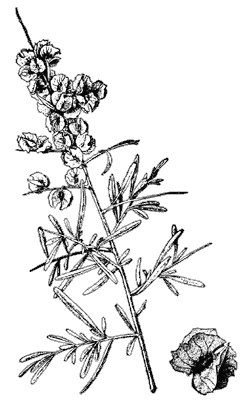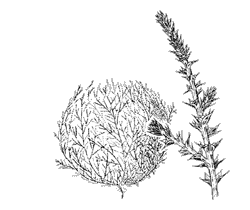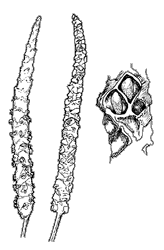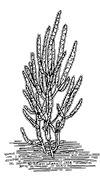Chenopodiaceae (goosefoot family)
The approximately 1300 species of chenopods worldwide range from annual herbs to trees. Many species have C4 photosynthesis. The flowers are tiny and inconspicuous, but some species bear showy masses of fruits. Chenopods are common in deserts and especially in saline or alkaline soils. Spinach, beets, sugar beets, chard, and epazote are members with economic value. The most common chenopods in our region are several species of Atriplex (saltbush) and Chenopodium (goosefoot, pigweed); the latter genus contains both native and exotic herbs.
Atriplex canescens
English name: fourwing saltbush
Spanish names: cenizo (ash-gray), chamizo (thatch, brush), costilla de vaca (cow’s rib), saladillo (salted)
Description
Fourwing saltbush is a densely-branched, evergreen shrub 3 to 6 feet (1-2 m) tall with gray foliage. Female plants bear large masses of fruits, each with 4 large winglike membranes.
 |
Range
This shrub is widespread in the desert Southwest, centered in the Great Basin and extending into Canada, Mexico, and the western Great Plains. It is often the dominant plant in valleys with saline or alkaline soils.
Notes
There is something of a mystery concerning this saltbush’s ecological needs. Despite the significant climate changes from the glacial to the present interglacial period, the plant has stayed put—its geographic distribution in the southwest U.S. has not changed. On the other hand, its elevational range changes dramatically with soil type. It grows 1600 feet (500 m) higher on shale soils than on soils derived from igneous rocks.
The leaves of saltbush species appear grayish because they cope with saline soils by secreting excess salt into tiny hairs on the leaf surfaces. The hairs die from high salt concentration, leaving a deposit of salt crystals on the surface that reflects some of the intense light that would otherwise overload the photosynthetic system.
Cattlemen regard saltbush as drought insurance. Cattle rely on these bushes when grasses fail to produce a good crop due to insufficient rains.
Other species of Atriplex in our region include A. hymenelytra (desert holly) and A. lentiformis (quailbush). The former grows in mounds to 4 feet (1.2 m) tall and wide with white holly-shaped foliage; the latter gets much bigger, to 8 by 12 feet (2.4 by 3.7 m). Both species grow in the lowest desert elevations, as does another species with tiny leaves, A. polycarpa, desert saltbush, a shrub considered by far the most important browse plant in its range before agriculture displaced much of it. If water is available, these plants can photosynthesize on the hottest days, when most other plants are stressed and forced to shut down; they exemplify the adaptive value of C4 photosynthesis. A. lentiformis seeds were gathered by the O’odham as emergency food, and soap was made from the leaves.
Salsola tragus
[Salsola iberica, S. kali]
English names: Russian thistle, tumble- weed, wind witch, leap the field
Spanish names: chamizo volador
(flying bush), maromero
Description
Russian thistle is a nearly spherical annual herb, usually about 2 feet (60 cm) tall, but more than twice that in favorable conditions. The threadlike leaves are spine-tipped. The dried plant breaks from its root and blows across the ground, dispersing seeds as it tumbles.
Range
The plant is native to Eurasia, but now occurs all over western North America in disturbed soils.
 |
Notes
Though it’s an integral part of Western lore, tumbleweed is an exotic, very harmful weed. (The familiar song “Tumbling Tumbleweeds” was written in Tucson and first published as a poem in a University of Arizona literary quarterly. The Sons of the Pioneers, a singing group of the 1940s, made the song popular, and retired to Tucson 40 years later.)
Tumbleweed was first noticed in South Dakota in the 1880s, brought in as a contaminant in crop seeds from Europe. By the turn of the century it had spread to the Pacific coast and the Mexican border. It has become a troublesome pest in disturbed soils such as agricultural fields and graded road shoulders. It is rare or absent in undisturbed habitat. In some naturally unstable habitats, such as sand dunes, Russian thistle has become the dominant plant and is crowding out native species.
Salicornia bigelovii
English names: pickleweed, glasswort
Spanish name: none known
Description
This pickleweed is an annual halophyte (plant that tolerates salty soil). It consists of succulent jointed stems that resemble strings of little pickles; plants grow from less than a foot (30 cm) to 3 feet (0.9 m) tall in different populations. The inconspicuous flowers are wind-pollinated.
 |  |
Range
It grows only in the intertidal zone of estuarine salt marshes on both coasts of North America. On the west coast it occurs from Alaska to Nayarit, Mexico.
Notes
Although it often grows in pure stands, few people ever notice this plant, since most folks avoid the wet ground where it grows. But plantsman Jon Weeks, who studied it for more than a decade, enthusiastically promotes its merits. Almost all other true halophytes (plants that grow in salty soil) are perennial, probably because the metabolic rigors of dealing with saline environments makes yearly seed production difficult. But an annual must make seeds every year, and Salicornia bigelovii manages to devote up to 12% of its biomass to seeds. It is also one of the most extreme halophytes known—it can survive in water that has 5 to 6 times the salt concentration of sea water. It also requires salt water to thrive and reproduce; it wilts when it gets rained on.
Estuarine salt marshes are theaters of evolution since each marsh is an isolated island of saturated saline soil surrounded by dry land and sea. Along the desert coast of Sonora and elsewhere, each estuary has a unique ecotype (distinct genetic race) of pickleweed; these differ in such characters as plant height, seed size, and season of germination. Weeks can look at a plant in the lab and tell which estuary it was collected from.
This diversity will be valuable in domesticating pickleweed as a crop plant. The plant itself is of minimal utility for forage because up to half its dry weight is salt, though it might be used as fuel or diluted with other feed for forage. But the seeds have great potential. They are about N oil (fat) of very high quality. Different fractions of this oil are suitable for such varied uses as diesel fuel, lubricating oil, and margarine. The oil is more than half linoleic acid; an essential dietary fat for humans that does not contribute to heart disease. For these reasons pickleweed may become an economically viable crop, one that can be irrigated with sea water. If this comes to pass it will be both a blessing and a curse. Though we could increase food production by using thus-far-unfarmable coastal deserts, such agriculture would contribute to the destruction of coastal deserts all over the world.










